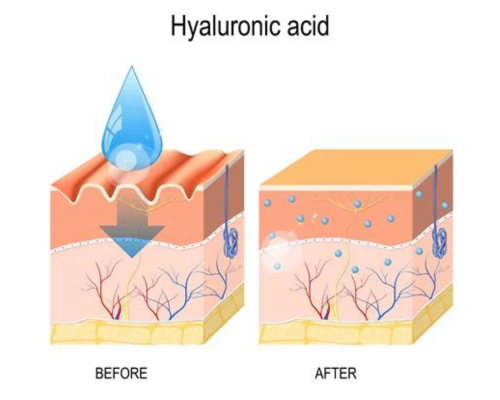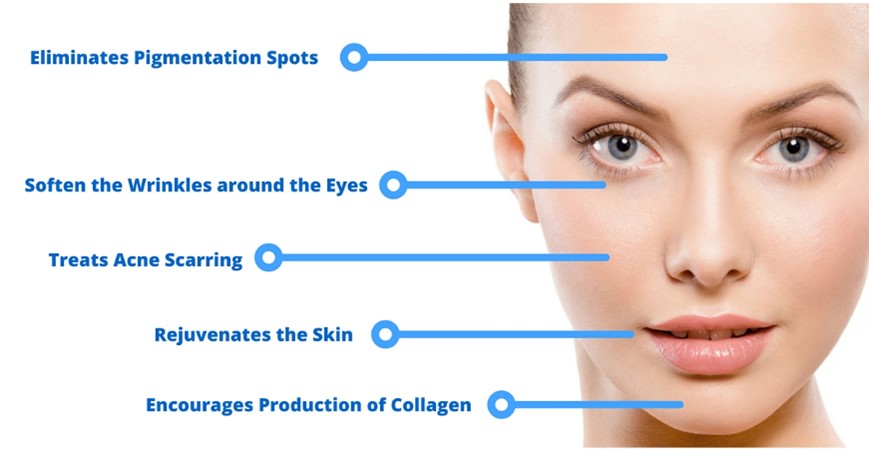Micro-Hyaluronic Acid: The Secret to Healthy, Hydrated Skin
Hyaluronic Acid (HA) has become a buzzword in the world of skincare and health, but its benefits go far beyond just hydration. Among its many forms, Micro-Hyaluronic Acid stands out for deeper skin penetration and enhanced anti-aging effects.
What is Hyaluronic Acid
Hyaluronic Acid (HA) is recognized as one of the best moisturizing substances currently discovered, regarded as the optimal humectant. It has an exceptional water-absorbing ability, capable of retaining water up to 1,000 times its own volume. HA is abundantly present in the skin, forming one of the main components of the skin’s extracellular matrix. This substance can bind with proteins to form larger proteoglycan molecules, ultimately creating a gel-like structure of hyaluronic acid-protein-water, which plays a crucial role in maintaining the skin’s moisture.
The Importance of Hyaluronic Acid for the Skin:
HA within the dermis provides space and nutrients for collagen and elastic fibers, forming a structural framework for the skin. This is essential for maintaining the stability, integration, and elasticity of skin tissues.
Hyaluronic Acids by Molecular Weight
Hyaluronic acid can be classified based on its molecular weight into:
- High Molecular Weight HA (HMW-HA): Above 1,800 KDa.
- Medium Molecular Weight HA (MMW-HA): Between 200 KDa and 1,800 KDa.
- Low Molecular Weight HA (LMW-HA): Between 5 KDa and 200 KDa.
- Oligomeric Hyaluronic Acid (Oligo-HA): Below 10 KDa.
Further subdivision identifies Micro-Hyaluronic Acid (Micro-HA) with a molecular weight below 5 KDa.
Learning more: Comparative Analysis of Hyaluronic Acid with Different Molecular Weights
Each molecular weight category has distinct physicochemical properties and application areas. HMW-HA is commonly used in ophthalmic and orthopedic surgical products due to its excellent viscoelasticity and lubricating properties. MMW-HA finds widespread applications in cosmetics, pharmaceuticals, and health products. LMW-HA is often used in cosmetics and health supplements for its better absorption. Oligo-HA and Micro-HA are primarily utilized in medical and cosmetic products.
What is Micro-Hyaluronic Acid
Micro-HA refers to ultra-low molecular weight HA fragments (below 5 KDa) obtained through the degradation of hyaluronic acid. Studies have shown that Micro-HA can quickly penetrate beneath the stratum corneum, providing long-lasting hydration to the skin. As a natural component of the human body, Micro-HA has excellent biocompatibility, offering comprehensive moisturizing and anti-aging effects. It represents a new generation of hyaluronic acid products.
Micro- Hyaluronic Acid vs. Regular Hyaluronic Acid
Micro-sodium hyaluronate stands out from regular sodium hyaluronate with the following features:
- Ultra-Low Molecular Weight: Micro-sodium hyaluronate has a molecular weight of less than 5 kDa.
- Strong Permeability: Its superior permeability allows it to penetrate the stratum corneum and reach the basal layer of the skin.
- Enhanced Moisturizing Ability: The moisturizing effect of micro-sodium hyaluronate is 6-7 times stronger than that of regular sodium hyaluronate.
- Superior Skin Affinity: While regular sodium hyaluronate forms a film on the skin’s surface that is easily washed off, micro-sodium hyaluronate binds to skin cells, providing robust hydration support and protection that is less prone to being washed away.
Advantages of Micro-Hyaluronic Acid
- Deep Moisturization
Micro-HA can penetrate the skin and provide deep hydration, significantly increasing skin moisture content. When combined with high molecular weight HA, the moisturizing effect is further enhanced synergistically.
- Repair of Damaged Cells
Micro-HA repairs damaged cells, enhancing cellular activity and reducing damage caused by external factors.
- Free Radical Scavenging
Micro-HA eliminates reactive oxygen species induced by sunlight, enhancing cellular antioxidant capacity and improving the skin’s defense against UVB radiation.
- Anti-Aging
Continuous use of skincare products containing Micro-HA improves skin elasticity, strengthens the skin barrier, reduces wrinkles, and provides anti-aging benefits.
How Does Micro-Hyaluronic Acid Benefit the Skin
High molecular weight hyaluronic acid cannot penetrate the normal skin barrier and forms a breathable thin film on the skin surface. Its primary function is to keep the skin smooth and moisturized while protecting it from bacteria, dust, and UV radiation. In contrast, low molecular weight HA can penetrate the skin barrier to the dermis, suppress inflammatory responses, promote angiogenesis, improve intermediate metabolism, enhance nutrient absorption, and reduce wrinkles.
In the dermis, Micro-HA participates in the metabolism of collagen and elastic fibers, providing moisture and nutrients and enhancing skin elasticity.
In vitro experiments have shown that Micro-HA can:
- Increase collagen synthesis (+100%)
- Activate glutamine transaminase (+100%)
- Reduce matrix metalloproteinase activity (-15%)
Collagen is a key extracellular matrix component responsible for skin strength, while the proper organization and alignment of collagen fibers involve glutamine transaminase. Matrix metalloproteinases degrade collagen fibers. In summary, Micro-HA exerts anti-wrinkle effects by acting on these substances within the body.
Where to Buy the Best Micro Hyaluronic Acid
Stanford Chemicals Company (SCC) is a wholesale supplier of pure organic hyaluronic acid in the USA. The company has rich experience in medical-grade, cosmetic-grade, Injection-Grade, and food-grade sodium hyaluronate. The high molecular weight, middle molecular weight, low molecular, and oligomeric weight hyaluronic acid powder are available as well. We offer hyaluronic acid raw materials to customers in the USA, Canada, and Europe. A detailed description of Micro-HA is listed below. For further information, please make your inquiry.
020-000-118 Micro Hyaluronic Acid Specification
| Product name | Super Active Hyaluronic Acid |
| INCI Name | Hydrolyzed Sodium Hyaluronate |
| Molecular weight | <5k Da (average: 3k Da) |
| Appearance | Almost white or pale yellow powder |
| Recommended dosage | 0.05%-0.5% |
| Solubility | Soluble in water; Can be added directly to water |
| Application | skincare, eye drops for lubrication, dermal fillers, joint supplements, and wound care |


